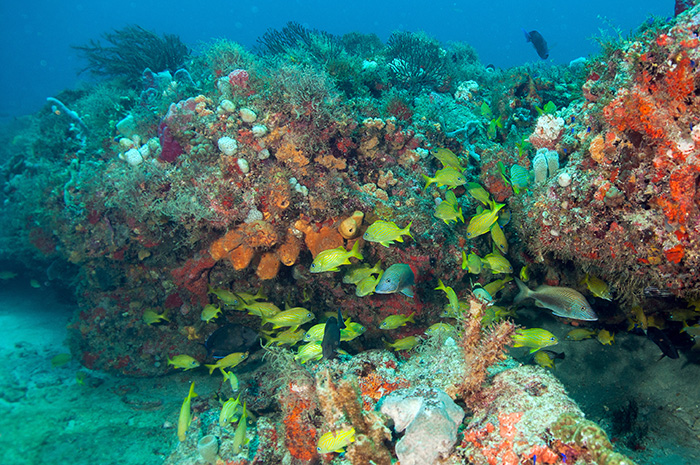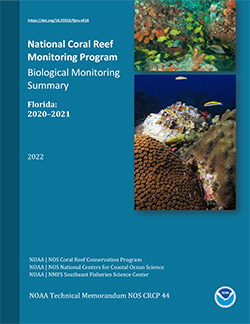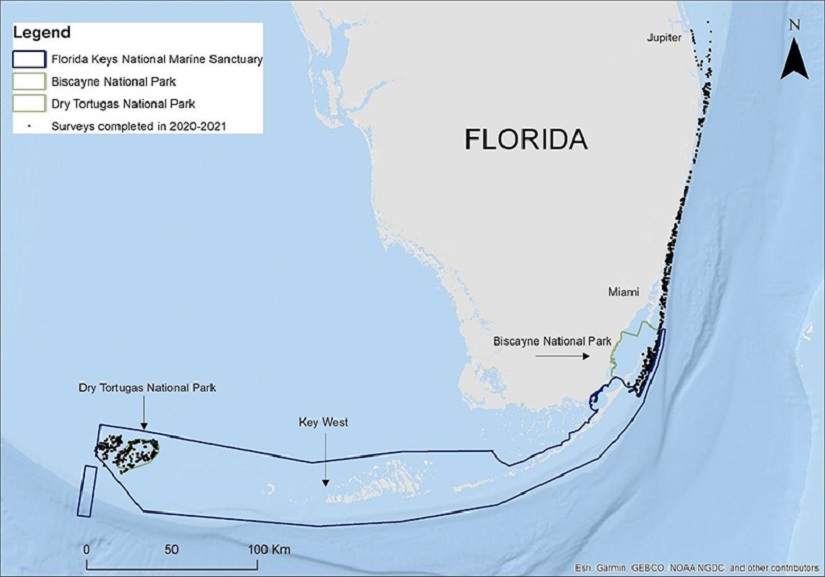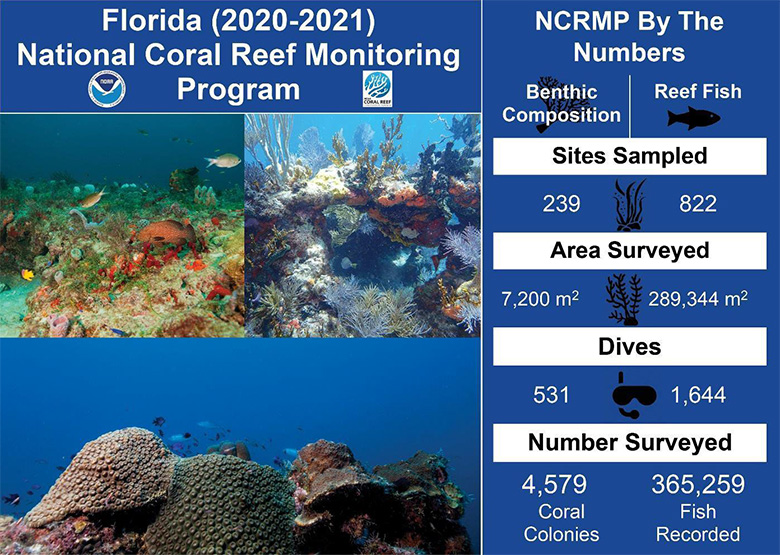- ABOUT US
- PROGRAM AREAS
- CONSERVATION APPROACH
- EDUCATION
- MULTIMEDIA
- The fishery target species with the highest mean density varied by region from yellowtail snapper (Ocyurus chrysurus) in the Dry Tortugas to gray triggerfish (Balistes capriscus) in Southeast Florida.
- Reefs in all locations were dominated by fishery non-targeted species including masked goby (Coryphopterus personatus), bicolor damselfish (Stegastes partitus), and bluehead wrasse (Thalassoma bifasciatum).
- Stony Coral Tissue Loss Disease was first reported in the Dry Tortugas in July 2021. Coral cover continues to decline in all Florida regions.
- New Report Shows Trends from Biological Monitoring in the U.S. Virgin Islands and Puerto Rico
- National Coral Reef Monitoring Program Socioeconomic Monitoring Component. Summary Findings for South Florida, 2019
- A National Status Report on United States Coral Reefs from NOAA's National Coral Reef Monitoring Program
- National Coral Reef Monitoring Program - Status Reports
- 2021 Update to the National Coral Reef Monitoring Program
National Coral Reef Monitoring Program report summarizes latest status and trends for Florida's Coral Reef
A report released in October 2022 describes the status and trends of Florida's coral reef ecosystem using data from the National Coral Reef Monitoring Program (NCRMP). Key messages from this report are:


The technical report was designed for resource managers to be able to quickly interpret the most recent data from the region and is the first NCRMP report to summarize biological (fish, corals, and benthic community) changes over time between 2014 and 2021 on Florida's coral reef. Led by Dr. Jay Grove from the Southeast Fisheries Science Center (SEFSC), who is the fish team lead for NCRMP in the Atlantic/Caribbean/Gulf of Mexico region, the report represents a highly collaborative effort between scientists from the SEFSC, the National Centers for Coastal Ocean Science (NCCOS), and the Office for Coastal Management (OCM) Coral Reef Conservation Program (CRCP). It contains current status and trend information on fish, corals, and benthic communities that are presented at regional scales within the Florida reef tract: Dry Tortugas, Florida Keys, and Southeast Florida.
Click on the following link to read the full report: National Coral Reef Monitoring Program Biological Monitoring Summary, Florida: 2020-2021.

The sampling effort underpinning the report was atypical in 2020-2021 due to the COVID-19 pandemic. A complete sampling effort typically occurs throughout the Florida reef tract during a single calendar year (e.g., 2020); however, sampling extended into an additional year (2021) due to pandemic-related fieldwork limitations. Overall, the field sampling effort was successful in the Dry Tortugas and Southeast Florida, but was limited in the Florida Keys. Despite these challenges due to COVID-19, exceptional partner collaboration, participation, and commitment led to a total of 1,644 dives for fish surveys and a total of 531 dives for coral and benthic community surveys, which are summarized in the infographic below. Other impressive summary values shown on the infographic include a total of 365,259 fish and 4,579 coral colonies were surveyed at a total of 239 benthic sites covering 7,200 square meters and 822 fish sites covering 289,344 square meters, respectively.

NCRMP monitors coral reef ecosystems in all U.S. states and territories that have coral reefs. There are four data theme areas in NCRMP: fish, corals and benthic communities, climate, and socioeconomics. NCRMP strives to produce a variety of data products targeted for different audiences, such as report cards designed for the public and policy makers, technical reports designed for natural resource managers, and peer-reviewed papers designed for the academic community.
For more information, contact Erica Towle.
Related Stories and Products
About Us

The NOAA Coral Reef Conservation Program was established in 2000 by the Coral Reef Conservation Act. Headquartered in Silver Spring, Maryland, the program is part of NOAA's Office for Coastal Management.

The Coral Reef Information System (CoRIS) is the program's information portal that provides access to NOAA coral reef data and products.
Work With US
U.S. Coral Reef Task Force
Funding Opportunities
Employment
Fellowship Program
Contracting Assistance
Graphic Identifier
Featured Stories Archive

Access the archive of featured stories here...
Feedback
Thank you for visiting NOAA’s Coral Reef Conservation Program online. Please take our website satisfaction survey. We welcome your ideas, comments, and feedback. Questions? Email coralreef@noaa.gov.
Stay Connected
Contact Us
NOAA’s Coral Reef Conservation Program
SSMC4, 10th Floor
1305 East West Highway
Silver Spring, MD 20910
coralreef@noaa.gov
